Religion in Medieval England
Medieval Religion Unlike religion in the modern world, medieval religion had deep significance and central importance in the lives of most individuals and nations. There was hardly any concept of a secular nation where religion did not play any role in the affairs of the states Religion in Medieval England includes all forms of religious organisation, practice and belief in England, between the end of Roman authority in the fifth century and the advent of Tudor dynasty in the late fifteenth century. The collapse of Roman authority brought about the end of formal Christian religion in the east of what is now England as Anglo-Saxon invaders took control of large sections of the island. The movement towards Christianity began again in the late sixth and seventh centuries. Pope Gregory I sent a team of missionaries who gradually converted most of the Anglo-Saxon kingdoms, while Scots-Irish monks were active in the north of England. The process was largely complete by the end of the seventh century, but left a confusing and disparate array of local practices and religious ceremonies. The Viking invasions of the eighth and ninth centuries reintroduced paganism to North-East England, leading in turn to another wave of conversions.
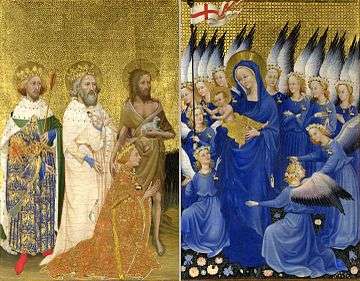
The process of conversions led to an explosion of local church buildings and monasteries formed the main basis for the church. Cathedrals were also constructed. These institutions were badly affected in the ninth century by Viking raids and predatory annexations by the nobility. Reforms followed under the kings of Wessex who promoted the Benedictine rule then popular on the Continent. The 1066 Norman conquest brought a new set of Norman and French churchmen to power; some adopted and embraced aspects of the former Anglo-Saxon religious system, while others introduced practices from Normandy. The French Cluniac order became fashionable and the Augustinians spread quickly from the beginning of the twelfth century, while later in the century the Cistercians reached England. The Dominican and Franciscan friars arrived in England during the 1220s, as well as the religious military orders that became popular across Europe from the twelfth century.
The Church had a close relationship with the English state throughout the Middle Ages. The bishops and major monastic leaders played an important part in national government. After the Norman Conquest kings and archbishops clashed over rights of appointment and religious policy. By the early thirteenth century the church had largely won its argument for independence. Pilgrimages were a popular religious practice throughout the Middle Ages in England. Participation in the Crusades was also seen as a form of pilgrimage, and England played a prominent part in the Second, Third and Fifth Crusades. In the 1380s, several challenges emerged to the traditional theology of the Church, resulting from the teachings of John Wycliffe.
Christianisation
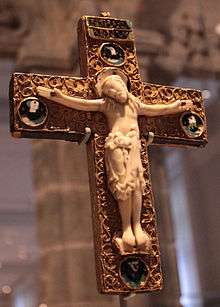
Christianity had been the official imperial religion of the Roman Empire, and the first churches were built in England in the second half of the fourth century, overseen by a hierarchy of bishops and priests. Many existing pagan shrines were converted to Christian use and few pagan sites still operated by the fifth century.[1] The collapse of the Roman system in the late fifth century, however, brought about the end of formal Christian religion in the east of England, and the new Germanic immigrants arrived with their own polytheistic gods, including Woden, Thunor and Tiw, still reflected in various English place names.[2] Despite the resurgence of paganism in England, Christian communities still survived in more western areas such as Gloucestershire and Somerset.[3]
The movement towards Christianity began again in the late sixth and seventh centuries, helped by the conversion of the Franks in Northern France, who carried considerable influence in England. Pope Gregory I sent a team of missionaries to convert King Æthelberht of Kent and his household, starting the process of converting Kent. Augustine became the first Archbishop of Canterbury and started to build new churches across the South-East, reusing existing pagan shrines. Oswald and Oswiu, kings of Northumbria, were converted in the 630s and 640s by Scottish missionaries, and the wave of change carried on through the middle of the seventh century across the kingdoms of Mercia, the South Saxons and the Isle of Wight.[4] The process was largely complete by the end of the seventh century, but left a confusing and disparate array of local practices and religious ceremonies.[5] This new Christianity reflected the existing military culture of the Anglo-Saxons: as kings began to convert in the sixth and seventh centuries, conversion began to be used as a justification for war against the remaining pagan kingdoms, for example, while Christian saints were imbued with martial properties.[6] The Council of Hertford in 673 was the first meeting of bishops from across England; it established a hierarchy in England and confirmed the observance of the traditions of the Latin Church over those of the Celtic Church, which had previously held influence in the north and west.[7]
The Viking invasions of the eighth and ninth centuries reintroduced paganism to North-East England, leading in turn to another wave of conversion. Indigenous Scandinavian beliefs were very similar to other Germanic groups, with a pantheon of gods including Odin, Thor and Ullr, combined with a belief in a final, apocalyptic battle called Ragnarok.[8] The Norse settlers in England were converted relatively quickly, assimilating their beliefs into Christianity in the decades following the occupation of York, of which the Archbishop had survived. The process was largely complete by the early tenth century and enabled England's leading Churchmen to negotiate with the warlords.[9] As the Norse in mainland Scandinavia started to convert, many mainland rulers recruited missionaries from England to assist in the process.[10]
Religious institutions
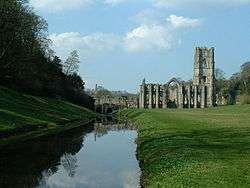
With the conversion of much of England in the sixth and seventh centuries, there was an explosion of local church building.[11] English monasteries formed the main basis for the church and were often sponsored by local rulers. They took various forms, including mixed communities headed by abbesses, bishop-led communities of monks, and others formed around married priests and their families.[12] Cathedrals were constructed, staffed either with secular canons in the European tradition or, uniquely to England, chapters of monks.[13] These institutions were badly affected in the ninth century by Viking raids and predatory annexations by the nobility.[14] By the start of the tenth century, monastic lands, financial resources and the quality of monasteries' religious work had been much diminished.[15] Reforms followed under the kings of Wessex who promoted the Benedictine rule then popular on the Continent.[16] A reformed network of around 40 monastic institutions across the south and east of England, under the protection of the king, helped re-establish royal control over the reconquered Danelaw.[17]
The 1066 Norman conquest brought a new set of Norman and French churchmen to power; some adopted and embraced aspects of the former Anglo-Saxon religious system, while others introduced practices from Normandy.[18] Extensive English lands were granted to monasteries in Normandy, allowing them to create daughter priories and monastic cells across the kingdom.[19] The monasteries were brought firmly into the web of feudal relations, with their holding of land linked to the provision of military support to the crown.[20] The Normans adopted the Anglo-Saxon model of monastic cathedral communities, and within seventy years the majority of English cathedrals were controlled by monks; every English cathedral, however, was rebuilt to some extent by the new rulers.[21] England's bishops remained powerful temporal figures, and in the early twelfth-century raised armies against Scottish invaders and built up extensive holdings of castles across the country.[22]
New religious orders began to be introduced into England. As ties to Normandy waned, the French Cluniac order became fashionable and their houses were introduced in England.[23] The Augustinians spread quickly from the beginning of the twelfth century, while later in the century the Cistercians reached England, creating houses with a more austere interpretation of the monastic rules and building the great abbeys of Rievaulx and Fountains.[24] By 1215, there were over 600 monastic communities in England, but new endowments slowed during the thirteenth century, creating long-term financial problems for many institutions.[25] The Dominican and Franciscan friars arrived in England during the 1220s, establishing 150 friaries by the end of the thirteenth century; these mendicant orders rapidly became popular, particularly in towns, and heavily influenced local preaching.[26] The religious military orders that became popular across Europe from the twelfth century acquired possessions in England, including the Templars, Teutonic Knights and Hospitallers.[27]
Church and state
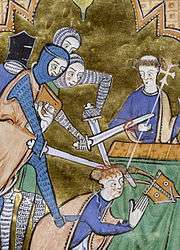
The Church had a close relationship with the English state throughout the Middle Ages. The bishops and major monastic leaders played an important part in national government, having key roles on the king's council.[28] Bishops often oversaw towns and cities, managing local taxation and government. This frequently became untenable with the Viking incursions of the ninth century, and in locations such as Worcester the local bishops came to new accommodations with the local ealdormen, exchanging some authority and revenue for assistance in defence.[29] The early English church was racked with disagreement on doctrine, which was addressed by the Synod of Whitby in 664; some issues were resolved, but arguments between the archbishops of Canterbury and York as to which had primacy across Britain began shortly afterwards and continued throughout most of the medieval period.[30]
William the Conqueror acquired the support of the Church for the invasion of England by promising ecclesiastical reform.[31] William promoted celibacy amongst the clergy and gave ecclesiastical courts more power, but also reduced the Church's direct links to Rome and made it more accountable to the king.[32] Tensions arose between these practices and the reforming movement of Pope Gregory VII, which advocated greater autonomy from royal authority for the clergy, condemned the practice of simony and promoted greater influence for the papacy in church matters.[33] Despite the bishops continuing to play a major part in royal government, tensions emerged between the kings of England and key leaders within the English Church. Kings and archbishops clashed over rights of appointment and religious policy, and successive archbishops including Anselm, Theobald of Bec, Thomas Becket and Stephen Langton were variously forced into exile, arrested by royal knights or even killed.[34] By the early thirteenth century, however, the church had largely won its argument for independence, answering almost entirely to Rome.[35]
Bishops held considerable secular responsibilities. As tenants-in-chief of the crown, they were responsible for providing a quota of armed knights for the king's army. Although they weren't expected be involved in actual combat, several bishops became active military leaders; an example is Thurstan, Archbishop of York, who mustered the army that defeated the Scots at the Battle of the Standard in 1138. Bishops were also responsible for administering their huge estates and presiding in the courts that dealt with civil disputes within them.[36] They were also required to attend royal councils, and with the development of the Parliament of England in the 13th century, the two archbishops and nineteen bishops were required to take their seats in the House of Lords, along with the abbots and priors of the largest religious houses; collectively, they were known as the Lords Spiritual.[37]
Pilgrimages
Pilgrimages were a popular religious practice throughout the Middle Ages in England.[38] Typically pilgrims would travel short distances to a shrine or a particular church, either to do penance for a perceived sin, or to seek relief from an illness or other condition.[39] Some pilgrims travelled further, either to more distant sites within Britain or, in a few cases, onto the continent.[40]
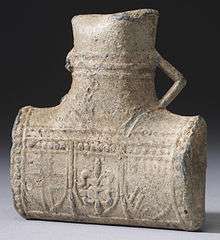
During the Anglo-Saxon period, many shrines were built on former pagan sites which became popular pilgrimage destinations, while other pilgrims visited prominent monasteries and sites of learning.[41] Senior nobles or kings would travel to Rome, which was a popular destination from the seventh century; sometimes these trips were a form of convenient political exile.[42] Under the Normans, religious institutions with important shrines, such as Glastonbury, Canterbury and Winchester, promoted themselves as pilgrimage destinations, maximising the value of the historic miracles associated with the sites.[43] Accumulating relics became an important task for ambitious institutions, as these were believed to hold curative powers and lent status to the site.[44] By the twelfth century reports of posthumous miracles by local saints were becoming increasingly common in England, adding to the attractiveness of pilgrimages to prominent relics.[45] Major shrines in the late Middle Ages included those of Thomas Becket at Canterbury, Edward the Confessor, at Westminster Abbey, Hugh of Lincoln, William of York, Edmund Rich, Archbishop of Canterbury, who was buried at Pontigny Abbey in France, Richard of Chichester, Thomas Cantilupe of Hereford, St Osmund of Salisbury and John of Bridlington.[46]
Crusades
Participation in the Crusades was also seen as a form of pilgrimage, and the same Latin word, peregrinatio, was sometimes applied to both activities.[47] While English participation in the First Crusade between 1095–99 was limited, England played a prominent part in the Second, Third and Fifth Crusades over the next two centuries, with many crusaders leaving for the Levant during the intervening years.[48] The idea of undertaking a pilgrimage to Jerusalem was not new in England, however, as the idea of religiously justified warfare went back to Anglo-Saxon times.[49] Many of those who took up the Cross to go on a Crusade never actually left, often because the individual lacked sufficient funds to undertake the journey.[50] Raising funds to travel typically involved crusaders selling or mortgaging their lands and possessions, which affected their families and, at times, considerably affected the economy as a whole.[51]
Heresy
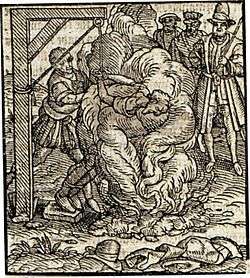
In the 1380s, several challenges emerged to the traditional teachings of the Church, resulting from the teachings of John Wycliffe, a member of Oxford University.[52] Wycliffe argued that scripture was the best guide to understanding God's intentions, and that the superficial nature of the liturgy, combined with the abuses of wealth within the Church and the role of senior churchmen in government, distracted from that study.[53] A loose movement that included many members of the gentry pursued these ideas after Wycliffe's death in 1384 and attempted to pass a Parliamentary bill in 1395: the movement was rapidly condemned by the authorities and was termed "Lollardy".[54] The English bishops were charged to control and counter this trend, disrupting Lollard preachers and to enforcing the teaching of suitable sermons in local churches.[55] By the early fifteenth century, combating Lollard teachings had become a key political issue, championed by Henry IV and his Lancastrian followers, who used the powers of both the church and state to combat the heresy.[56] Events came to a head in 1414 at the beginning of the reign of Henry V when Sir John Oldcastle, a suspected Lollard, escaped from imprisonment, prompting a planned rising in London. However, the authorities learned of the plans and arrested the conspirators, resulting in a further round of political trials and persecutions. Oldcastle was captured and executed in 1417 and Lollardy continued as a secret minority sect.[57]
.jpg)
Judaism
The first substantial Jewish population in England arrived after the Norman Conquest, reportedly migrating from Rouen in Normandy.[58] By the mid-12th century, there were Jewish communities in most of England's major cities. Although there were violent anti-Jewish massacres and riots in several cities, Jews were theoretically under the protection of the Crown because of their financial importance.[59] However, in 1275, King Edward I passed the Statute of Jewry, which compelled Jews to be identified by a yellow badge and outlawed usury, the lending of money for interest, which was the main source of income for many Jewish families. Following increasing state persecution and attempts to force conversion to Christianity, Edward finally expelled all Jews from England in 1290.[60]
References
Notes
- Fleming 2000, pp. 121 and 126
- Whitelock 1972, pp. 21–22; Fleming 2000, pp. 127
- Fleming 2000, pp. 156–157
- Fleming 2000, pp. 152–153
- Fleming 2000, pp. 160–161
- Lavelle 2010, pp. 8 and 11–12
- Cross and Livingstone, p. 767
- Sawyer 2010, pp. 131
- Lavelle 1982, pp. 319; Rahtz and Watts 2003, pp. 303–305
- Lavelle 1982, pp. 140
- Nilson 2001, p. 70
- Fleming 2000, pp. 128–129 and 170–173
- Gilchrist 2006, p. 2
- Fleming 2000, pp. 318–319, 321
- Fleming 2000, p. 318
- Fleming 2000, pp. 322–323
- Fleming 2000, p. 322; Burton 1994, pp. 3–4
- Burton 1994, pp. 23–24.
- Burton 1994, pp. 29–30
- Burton 1994, p. 28
- Burton 1994, pp. 28–29; Nilson 2001, p. 70
- Huscroft 2005, pp. 126–127; Bradbury 2009, p. 36; Pounds 1994, pp. 142–143
- Burton 1994, pp. 36–38
- Carpenter 2004, pp. 444–445
- Carpenter 2004, p. 446; Danziger and Gillingham 2003, p. 208
- Carpenter 2004, pp. 448–450; Danziger and Gillingham 2003, pp. 209
- Forey 1991, pp. 98–99, 106–107
- Whitelock 1972, pp. 54–55
- Fleming 2000, pp. 246–247
- Whitelock 1972, pp. 160–163
- Burton 1994, p. 21; Barlow 1999, p. 75
- Barlow 1999, pp. 98 and 103–104
- Barlow 1999, p. 104; Duggan 1965, p. 67
- Hollister 2003, p. 168; Alexander 1972, pp. 2–3 and 10; Barlow 1999, pp. 83–84 and 88–89
- Barlow 1999, p. 361
- Wickson p. xxvi
- "Medieval House of Lords". www.parliament.uk. United Kingdom Parliament. Retrieved 27 November 2016.
- Webb 2000, p. 1
- Webb 2000, pp. xiii and xvi
- Webb 2000, pp. xvi–xvii
- Webb 2000, pp. 3–5.
- Webb 2000, pp. 5–6
- Webb 2000, pp. 19–21
- Webb 2000, pp. 24–27
- Webb 2000, pp. 35–38
- Webb 2000, p. 63
- Webb 2000, p. xii
- Carpenter 2004, p. 445
- Tyerman 1996, pp. 11 and 13
- Carpenter 2004, p. 456
- Carpenter 2004, p. 458; Tyerman 1996, pp. 16–17
- Rubin 2006, pp. 148–149
- Rubin 2006, pp. 149–150
- Rubin 2006, pp. 150–151; Aston and Richmond 1997, pp. 1–4
- Rubin 2006, p. 154
- Rubin 2006, pp. 198–199
- Deane 2011, pp. 232–34
- Terry p. 382
- Karesh and Hurvitz p. 137
- Rist p. 68
Bibliography
- Alexander, James W. (1970). "The Becket Controversy in Recent Historiography". The Journal of British Studies. 9 (2): 1–26. doi:10.1086/385589. JSTOR 175153.CS1 maint: ref=harv (link)
- Aston, Margaret; Richmond, Colin (1997). "Introduction". In Aston, Margaret; Richmond, Colin (eds.). Lollardy and the Gentry in the Later Middle Ages. Stroud, UK: Sutton. ISBN 978-0-312-17388-3.
- Barlow, Frank (1999). The Feudal Kingdom of England, 1042–1216. Harlow, UK: Pearson Education. ISBN 0582381177.CS1 maint: ref=harv (link)
- Bradbury, Jim (2009). Stephen and Matilda: the Civil War of 1139–53. Stroud, UK: The History Press. ISBN 978-0-7509-3793-1.CS1 maint: ref=harv (link)
- Burton, Janet E. (1994). Monastic and Religious Orders in Britain, 1000–1300. Cambridge, UK: Cambridge University Press. ISBN 978-0-521-37797-3.CS1 maint: ref=harv (link)
- Carpenter, David (2004). The Struggle for Mastery: The Penguin History of Britain 1066–1284. London: Penguin. ISBN 978-0-14-014824-4.CS1 maint: ref=harv (link)
- Cross, Frank Leslie; Livingstone, Elizabeth A (2005). The Oxford Dictionary of the Christian Church. Oxford University Press. ISBN 978-0-19280290-3.
- Danziger, Danny; Gillingham, John (2003). 1215: The Year of Magna Carta. Hodder & Stoughton. ISBN 978-0-340-82475-7.
- Duggan, Charles (1962). "The Becket Dispute and the Criminous Clerks". Bulletin of the Institute of Historical Research. 35 (91): 1–28. doi:10.1111/j.1468-2281.1962.tb01411.x.CS1 maint: ref=harv (link)
- Fleming, Robin (2000). Britain After Rome: The Fall and Rise, 400 to 1070. London: Penguin Books. ISBN 978-0-14-014823-7.CS1 maint: ref=harv (link)
- Forey, Alan (1992). The Military Orders From the Twelfth to the Early Fourteenth Centuries. Basingstoke, UK: Macmillan. ISBN 978-0-333-46235-5.CS1 maint: ref=harv (link)
- Gilchrist, Roberta (2006). Norwich Cathedral Close: The Evolution of the English Cathedral Landscape. Woodbridge, UK: Boydell Press. ISBN 978-1-84383-173-0.CS1 maint: ref=harv (link)
- Hollister, C. Warren (2003). Henry I (Yale ed.). New Haven, U.S.: Yale University Press. ISBN 978-0-300-09829-7.CS1 maint: ref=harv (link)
- Huscroft, Richard (2005). Ruling England, 1042–1217. Harlow, UK: Pearson. ISBN 0-582-84882-2.CS1 maint: ref=harv (link)
- Deane, Jennifer Kolpacoff (2011). A History of Medieval Heresy and Inquisition. London: Rowman & Littlefield. ISBN 0-7425-6811-3.CS1 maint: ref=harv (link)
- Karesh, Sara E; Hurvitz, Mitchell M (2006). Encyclopedia of Judaism. New York: Facts On File Inc. ISBN 0-8160-5457-6.
- Lavelle, Ryan (2010). Alfred's Wars: Sources and Interpretations of Anglo-Saxon Warfare in the Viking Age. Woodbridge, UK: Boydell Press. ISBN 978-1-84383-569-1.CS1 maint: ref=harv (link)
- Rubin, Miri (2006). The Hollow Crown: The Penguin History of Britain 1272–1485. Penguin. ISBN 978-0-14-014825-1.CS1 maint: ref=harv (link)
- Nilson, Ben (2001). Cathedral Shrines of Medieval England. Woodbridge, UK: Boydell Press. ISBN 978-0-85115-808-2.CS1 maint: ref=harv (link)
- Pounds, Norman John Greville (1994). The Medieval Castle in England and Wales: A Social and Political History. Cambridge, UK: Cambridge University Press. ISBN 978-0-521-45828-3.CS1 maint: ref=harv (link)
- Rahtz, Philip; Watts, Lorna (2005). "Three Ages of Conversion at Kirkdale, North Yorkshire". In Carver, Martin (ed.). The Cross Goes North: Processes of Conversion in Northern Europe, AD 300–1300. Woodbridge, UK: Boydell Press. ISBN 1843831252.
- Rist, Rebecca (2016). Popes and Jews, 1095-1291. Oxford University Press. ISBN 978-0-19-871798-0.
- Sawyer, P. H. (1982). Kings and Vikings: Scandinavia and Europe, AD 700–1100. London: Routledge. ISBN 978-0-415-04590-2.CS1 maint: ref=harv (link)
- Terry, Michael (2000). Reader's Guide to Judaism. Routledge. ISBN 1-57958-139-0.
- Tyerman, Christopher (1996). England and the Crusades, 1095–1588. Chicago, US: University of Chicago Press. ISBN 978-0-226-82013-2.CS1 maint: ref=harv (link)
- Webb, Diana (2000). Pilgrimage in Medieval England. London: Hambledon. ISBN 978-1-85285-250-4.CS1 maint: ref=harv (link)
- Wickson, Roger (2015). Kings and Bishops in Medieval England, 1066-1216. Palgrave. ISBN 978-1-137-43116-5.
- Whitelock, Dorothy (1972). The Beginnings of English Society (2nd ed.). Harmondsworth, UK: Penguin Books. ISBN 0-14-020245-5.CS1 maint: ref=harv (link)